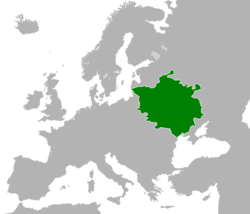
Grand Duchy of Lithuania
European state from c. 1236 to 1795 / From Wikipedia, the free encyclopedia
Dear Wikiwand AI, let's keep it short by simply answering these key questions:
Can you list the top facts and stats about Grand Duchy of Lithuania?
Summarize this article for a 10 year old
The Grand Duchy of Lithuania was a sovereign state in northeastern Europe that existed from the 13th century,[5] succeeding the Kingdom of Lithuania, to the late 18th century,[6] when the territory was suppressed during the 1795 partitions of Poland–Lithuania. The state was founded by Lithuanians, who were at the time a polytheistic nation of several united Baltic tribes from Aukštaitija, which by 1440, became the largest European state controlling an area from the Baltic Sea in the north to the Black Sea in the south.[7][8][9]
Grand Duchy of Lithuania | |||||||||||||
|---|---|---|---|---|---|---|---|---|---|---|---|---|---|
| c. 1236–1795[lower-alpha 1] | |||||||||||||
 The Grand Duchy of Lithuania at the height of its power in the 15th century. | |||||||||||||
| Status |
| ||||||||||||
| Capital | |||||||||||||
| Common languages | Lithuanian, Ruthenian, Polish, Latin, German, Yiddish, Tatar, Karaim (see § Languages) | ||||||||||||
| Religion | |||||||||||||
| Government |
| ||||||||||||
| Grand Duke | |||||||||||||
• 1236–1263 (from 1251 as King) | Mindaugas (first) | ||||||||||||
• 1764–1795 | Stanisław August Poniatowski (last) | ||||||||||||
| Legislature | Seimas | ||||||||||||
• Privy Council | Council of Lords | ||||||||||||
| History | |||||||||||||
• Consolidation began | 1180s | ||||||||||||
| 1251–1263 | |||||||||||||
| 14 August 1385 | |||||||||||||
| 1 July 1569 | |||||||||||||
| 24 October 1795 | |||||||||||||
| Area | |||||||||||||
| 1260[4] | 200,000 km2 (77,000 sq mi) | ||||||||||||
| 1430[4] | 930,000 km2 (360,000 sq mi) | ||||||||||||
| 1572[4] | 320,000 km2 (120,000 sq mi) | ||||||||||||
| 1791[4] | 250,000 km2 (97,000 sq mi) | ||||||||||||
| 1793[4] | 132,000 km2 (51,000 sq mi) | ||||||||||||
| Population | |||||||||||||
• 1260[4] | 400,000 | ||||||||||||
• 1430[4] | 2,500,000 | ||||||||||||
• 1572[4] | 1,700,000 | ||||||||||||
• 1791[4] | 2,500,000 | ||||||||||||
• 1793[4] | 1,800,000 | ||||||||||||
| |||||||||||||
| |||||||||||||
The grand duchy expanded to include large portions of the former Kievan Rus' and other neighbouring states, including what is now Belarus, Lithuania, most of Ukraine as well as parts of Latvia, Moldova, Poland and Russia. At its greatest extent, in the 15th century, it was the largest state in Europe.[10] It was a multi-ethnic and multiconfessional state, with great diversity in languages, religion, and cultural heritage.
The consolidation of the Lithuanian lands began in the late 13th century. Mindaugas, the first ruler of the grand duchy, was crowned as the Catholic King of Lithuania in 1253. The pagan state was targeted in a religious crusade by the Teutonic Knights and the Livonian Order, but survived. Its rapid territorial expansion started late in the reign of Gediminas,[11] and continued under the diarchy and co-leadership of his sons, Algirdas and Kęstutis.[12] Algirdas's son Jogaila signed the Union of Krewo in 1386, bringing two major changes in the history of the Grand Duchy of Lithuania: conversion to Christianity of Europe's last pagan state,[13] and establishment of a dynastic union between the Grand Duchy of Lithuania and the Crown of the Kingdom of Poland.[14] This marked the beginning of the rule of other countries by the patrilineal members of the Lithuanian ruling Gediminids dynasty who since the 14th–15th centuries ruled not only Lithuania, but also Poland, Hungary, Croatia, Bohemia, and Moldavia.[15][16]
The reign of Vytautas the Great, son of Kęstutis, marked both the greatest territorial expansion of the grand duchy (it became one of the largest countries territorially in Europe) and the defeat of the Teutonic Knights in the Battle of Grunwald in 1410.[17] It also marked the rise of the Lithuanian nobility. After Vytautas's death, Lithuania's relationship with the Kingdom of Poland greatly deteriorated.[18] Lithuanian noblemen, including the Radvila family, attempted to break the personal union with Poland.[19] However, unsuccessful wars with the Grand Duchy of Moscow forced the union to remain intact.
Eventually, the Union of Lublin of 1569 created a new state, the Polish–Lithuanian Commonwealth. In the Federation, the Grand Duchy of Lithuania maintained its political distinctiveness and had separate ministries, laws, army, and treasury.[20] The federation was terminated by the passing of the Constitution of 3 May 1791, when it was supposed to become a single country, the Commonwealth, under one monarch, one parliament and no Lithuanian autonomy. Shortly afterward, the unitary character of the state was confirmed by adopting the Reciprocal Guarantee of Two Nations.
However, the newly reformed Commonwealth was invaded by Russia in 1792 and partitioned between neighbouring states. A truncated state (whose principal cities were Kraków, Warsaw and Vilnius) remained that was nominally independent. After the Kościuszko Uprising, the territory was completely partitioned among the Russian Empire, the Kingdom of Prussia and Austria in 1795.

